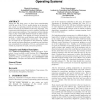Free Online Productivity Tools
i2Speak
i2Symbol
i2OCR
iTex2Img
iWeb2Print
iWeb2Shot
i2Type
iPdf2Split
iPdf2Merge
i2Bopomofo
i2Arabic
i2Style
i2Image
i2PDF
iLatex2Rtf
Sci2ools
SIGOPS
2008
2008
Using model checkers in an introductory course on operating systems
During the last three years, we have been experimenting with the use of the Uppaal model checker in an introductory course on operating systems for first-year Computer Science students at the Radboud University Nijmegen. The course uses model checkers as a tool to explain, visualize and solve concurrency problems. Our experience is that students enjoy to play with model checkers because it makes concurrency issues tangible. Even though it is hard to measure objectively, we think that model checkers really help students to obtain a deeper insight into concurrency. In this article, we report on our experiences in the classroom, explain how mutual exclusion algorithms, semaphores and monitors can conveniently be modeled in Uppaal, and present some results on properties of small, concurrent patterns. Categories and Subject Descriptors D.2.4 [Software Engineering]: Software/Program Verification--formal methods, model checking; D.4.1 [Operating Systems]: Process Management--concurrency, dea...
| Added | 15 Dec 2010 |
| Updated | 15 Dec 2010 |
| Type | Journal |
| Year | 2008 |
| Where | SIGOPS |
| Authors | Roelof Hamberg, Frits W. Vaandrager |
Comments (0)

